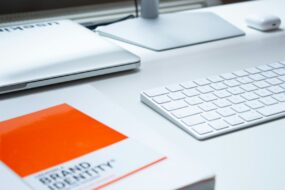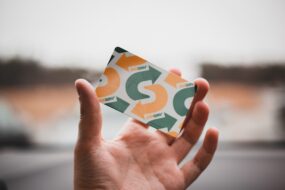
When I think about the purpose of a logo, I realize it serves as the visual cornerstone of a brand. A logo is not merely a decorative element; it encapsulates the essence of a business, conveying its values, mission, and personality in a single glance. It acts as a symbol that customers can easily recognize and associate with the products or services offered.
This recognition is crucial in a crowded marketplace where countless brands vie for attention. A well-designed logo can evoke emotions, create trust, and foster loyalty among consumers. Moreover, I understand that a logo is often the first point of contact between a brand and its audience.
It sets the tone for the entire brand experience, influencing how potential customers perceive the business. A strong logo can communicate professionalism and reliability, while a poorly designed one may lead to skepticism and doubt. Therefore, I must approach the design process with a clear understanding of what I want my logo to convey.
It’s essential to consider not just aesthetics but also the message I wish to communicate through this visual representation.
Key Takeaways
- Your logo should reflect the purpose and values of your brand
- Research your target audience and competition to understand what resonates with them
- Brainstorm and sketch multiple ideas to find the best concept for your logo
- Choose colors and fonts that align with your brand and appeal to your audience
- Create a versatile design that looks good in different formats and sizes
- Test your logo in various formats and sizes to ensure it remains effective
- Gather feedback and make revisions to refine your logo
- Implement your logo across different platforms to establish a consistent brand image
Researching Your Target Audience and Competition
Before diving into the design process, I recognize the importance of researching my target audience and competition. Understanding who my audience is will help me create a logo that resonates with them. I need to consider their demographics, preferences, and behaviors.
What do they value? What emotions do I want my logo to evoke in them? By answering these questions, I can tailor my design to meet their expectations and desires.
In addition to understanding my audience, I must also analyze my competition. Observing what works for other brands in my industry can provide valuable insights.
This research helps me identify trends and common themes while also allowing me to pinpoint gaps in the market that my logo can fill. By differentiating my brand visually from competitors, I can carve out a unique identity that stands out in consumers’ minds.
Brainstorming and Sketching Ideas

With a solid understanding of my audience and competition, I move on to brainstorming and sketching ideas for my logo. This stage is all about creativity and exploration. I allow myself to think freely, jotting down any concepts that come to mind without judgment.
Whether it’s abstract shapes, symbols that represent my brand’s values, or even playful typography, I embrace all possibilities during this phase. Once I have a collection of ideas, I begin sketching them out. This process is liberating; it allows me to visualize my thoughts and refine them further.
I don’t worry about perfection at this stage; instead, I focus on getting my ideas onto paper. As I sketch, I might find inspiration in unexpected places—nature, architecture, or even everyday objects. Each sketch serves as a stepping stone toward discovering a design that truly encapsulates my brand’s identity.
Choosing the Right Colors and Fonts
As I progress in the design process, selecting the right colors and fonts becomes paramount. Colors have psychological implications; they can evoke specific feelings and associations. For instance, blue often conveys trust and professionalism, while red can evoke passion and excitement.
I carefully consider what emotions I want my brand to evoke and choose colors that align with those feelings. Additionally, I think about how these colors will work together harmoniously to create a cohesive look. Fonts also play a crucial role in conveying my brand’s personality.
The typography I choose should reflect the tone of my business—whether it’s modern and sleek or classic and elegant. I experiment with different font styles, sizes, and weights to find the perfect combination that complements my logo design. It’s essential that the font is not only visually appealing but also legible across various platforms and sizes.
Creating a Versatile Design
In today’s digital age, versatility is key when designing a logo. I need to ensure that my logo looks great across various mediums—whether it’s on a website, social media profile, business card, or merchandise.
To achieve this, I focus on creating a logo that is simple yet impactful. Simplicity often leads to memorability; therefore, I strive to eliminate unnecessary elements that could clutter the design. A clean logo is more likely to be recognized and remembered by consumers.
Additionally, I consider how my logo will appear in both color and black-and-white formats. This adaptability ensures that my brand remains consistent even when color options are limited.
Testing Your Logo in Different Formats and Sizes

Once I have a draft of my logo design, it’s time to test it in different formats and sizes. This step is crucial for ensuring that my logo remains effective across various applications. I create mock-ups of how the logo will look on different platforms—such as websites, social media profiles, print materials, and promotional items.
By visualizing these scenarios, I can identify any potential issues with clarity or legibility. I also pay attention to how my logo performs at different sizes. A logo that looks great on a large banner may lose its impact when scaled down for a business card or social media avatar.
To address this, I make adjustments as needed to ensure that every detail remains clear and recognizable regardless of size. This testing phase helps me refine my design further before finalizing it.
Getting Feedback and Making Revisions
Feedback is an invaluable part of the design process, so I actively seek input from others once I have a refined version of my logo. Sharing my design with trusted friends, colleagues, or even potential customers allows me to gain fresh perspectives. They may notice aspects that I overlooked or provide insights into how the logo resonates with them emotionally.
Based on the feedback received, I am open to making revisions to enhance the design further. This iterative process allows me to fine-tune elements such as color balance, font choice, or overall composition. While it can be challenging to accept criticism at times, I remind myself that constructive feedback ultimately leads to a stronger final product.
Implementing Your Logo Across Different Platforms
Finally, once I have settled on a polished logo design, it’s time to implement it across various platforms. Consistency is key in building brand recognition; therefore, I ensure that my logo appears uniformly across all touchpoints—whether it’s on my website, social media channels, or printed materials. This cohesive branding reinforces my identity in the minds of consumers.
I also consider how my logo will adapt to different contexts while maintaining its core elements. For instance, on social media platforms where space is limited, I may use an abbreviated version of my logo or an icon derived from the main design. By being strategic about implementation while staying true to my brand identity, I can create a lasting impression on my audience.
In conclusion, designing a logo is an intricate process that requires careful consideration at every stage—from understanding its purpose to implementing it across various platforms. By conducting thorough research, brainstorming creatively, choosing appropriate colors and fonts, testing versatility, seeking feedback, and ensuring consistency in implementation, I can create a logo that not only represents my brand effectively but also resonates with my target audience for years to come.
FAQs
What is a brand logo?
A brand logo is a visual representation of a company’s identity and is used to promote instant public recognition.
Why is it important to have a lasting brand logo?
A lasting brand logo helps to build brand recognition and loyalty, and can save a company money in the long run by avoiding frequent rebranding.
What are the key elements of a successful brand logo?
A successful brand logo should be simple, memorable, versatile, timeless, and appropriate for the target audience.
What are the steps to designing a brand logo that lasts?
The steps to designing a lasting brand logo include conducting research, defining the brand’s message and values, sketching and conceptualizing ideas, refining the design, and testing the logo in various applications.
How can a brand logo be tested for longevity?
A brand logo can be tested for longevity by evaluating its scalability, adaptability to different mediums, and its ability to remain relevant over time.










No Comments